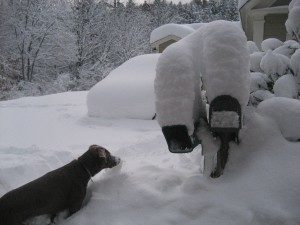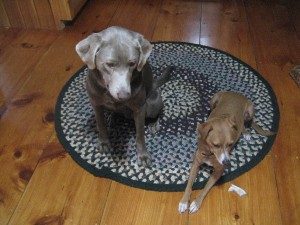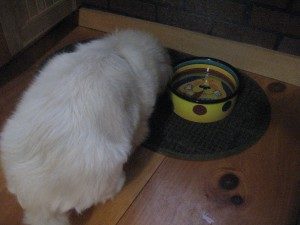
Our household was turned upside down last weekend. And it had nothing to do with the 31.5” of snow that was dumped on us.
The freak snow storm, dubbed Snowtober here in New Hampshire, did not have nearly the punch as our four-legged visitor, Raegan. She’s an energetic, one-year-old silver lab who we were watching for friends for a few days. Gizmo, a geriatric white fluff ball, came along for the visit, too, but you hardly knew she was here. There was no way to miss Raegan with her forceful approach (this 3-second video gives you an idea of how spirited her presence is; it was not easy to plow through this snow yet she comes through with power!).
[youtube]https://www.youtube.com/watch?v=M8rMNKSOtnY&context=C4559600ADvjVQa1PpcFOSCdS9Tkld4CsCZuJZhCBzosg5s3Ag8u4=[/youtube]

She’s big and strong (at least compared to Grace). She moves fast and has a commanding bark. Grace tolerates the play for a minute or two, but after that, she’s done. After realizing that Grace isn’t interested to frolic, Raegan is off in search of a new playmate, usually the nearest object in her path. Her darting movements scared the cats, so they sequestered themselves in the basement, but Raegan knew they were down there and occasionally called (i.e. barked) through the cat door for them. I’m sure she was making her plea: “Come play with me!!!” Not a chance, was the reply.
So in a matter of seconds of her arrival, the noise, activity level, and energy in the house had increased significantly. I had my moments of panic (when her feet landed on the counter as she came close to overturning a large tin of dog food), amazement and laughter (watching her wade through ice cold, muddy streams that Grace would never consider entering), and frustration (trying to redirect her nose that she was forcefully and urgently pushing close to the human food I was preparing).
At any time when I get stressed, I try to take a deep breath, then realize that I’m creating the stress in the moment, not the other person (or dog). Raegan was doing what any normal, active, healthy, one-year-old dog would be doing. I was the one who needed to make the adjustments in how we were going to co-exist to meet both our needs. So, what did I want to accomplish from her visit?
I knew I wanted to make Raegan (and Gizzy) feel welcome and loved in our house. But I did not want her to take over the house. So with these two objectives in mind, I focused on how to accomplish that. I knew how to make her feel welcome — as much play time as I could give her, along with lots of hands-on love. She always wants to be with you. Those would be fairly easy to accomplish.
The times that created the most stress (for me) were meals times and coming through doors. Activities that included eating and the anticipation of going outside to play put her into hyper-excitement mood.
Meal times were especially chaotic. Grace is exactly like Raegan in that they will devour whatever is within reach, whether it is theirs to have or not. Poor little Gizzy was nearly stampeded in their efforts to eat out of as many bowls as they could at the same time. So I decided to try to introduce some order.

I fed Gizzy last, when I could devote my attention to the two freeloaders. But first, before even feeding them, I asked them to sit and stay, with their filled bowls already on the floor. This was torture for Raegan but Grace has been through this drill so she was fairly easy to work with. For the first time, Grace was being a role model! (That’s a great reminder that teachers can be found in places you might not think to look.)

I was quite pleased with myself at Raegan’s progress but she was motivated to eat and it wasn’t too hard to get her to see the connection. Meal time turned into a time when we all were focused on doing a job rather than an out-of-control frenzy of chaos.
I carried over the sit/stay command before I allowed Raegan and Grace to walk through a door. Gizzy can’t half hear so she could come and go as she pleased. I figure that was teaching the younger pups to respect their elders.
Raegan was a good student about this but she wasn’t flawless, and of course neither was I. Sometimes I let her go if she leaped forward before I released her rather than calling her back to reinforce it. But overall, she tried hard to comply and I knew her real desire was to get out and play, not sit and wait. My plan to instill calm and orderly behavior was certainly not perfect. But it helped.
It reminded me of the seminar I attended where I learned from Suzanne Clothier to ask the question: “Who are you?” I kept that idea in my mind a lot with Raegan. She is a dog that loves people and fun. She always wants to be around you, and is constantly scanning for something playful to do or chew. Those are not high on Grace’s list, so it requires a lot more stimulation to keep Raegan entertained (or in other words, out of trouble).
Ever had someone in your office that had an entirely different energy than you did? It can be draining. It can also be a good balance. There were moments when being with Raegan were exhausting and other times when it was a real joy. We can benefit from these opportunities, if we stop to think about the other person and ask: “Who are you?” Or said another way, ‘what’s important to you?’ or ‘what motivates you?’
Our cats were proof of the benefits of exploring new relationships. Oliver and Dodger are two-year-old brothers who are confident and independent (what cat isn’t, I guess?) but they were clearly overpowered by the size and energy of Raegan. Yet, just one day after her arrival, Oliver was already starting to venture out of the basement. Carefully, he would slink by as quietly as possible past Raegan. That first time, he looked petrified. But after another few days, he was coming out more frequently and more visibly, walking with much more confidence in his step. He was learning how to take control of the situation and asking Raegan to accept his presence.
 Raegan is still really young and will soon mature out of her puppy behaviors. I know her owners also insist on good manners. But like any new relationships at work, we just need to know the rules of the environment we are in. Different companies have different cultures. Different managers value different behaviors. When conflicts or job performance don’t meet expectations, there needs to be a conversation to explore the whats and whys about the situation that have arisen.
Raegan is still really young and will soon mature out of her puppy behaviors. I know her owners also insist on good manners. But like any new relationships at work, we just need to know the rules of the environment we are in. Different companies have different cultures. Different managers value different behaviors. When conflicts or job performance don’t meet expectations, there needs to be a conversation to explore the whats and whys about the situation that have arisen.
Creating standards for how people work together is kind of like sitting and waiting for your dinner. Put the rules of conduct on the table first. Then allow others to play by the rules. That makes everyone happy.
